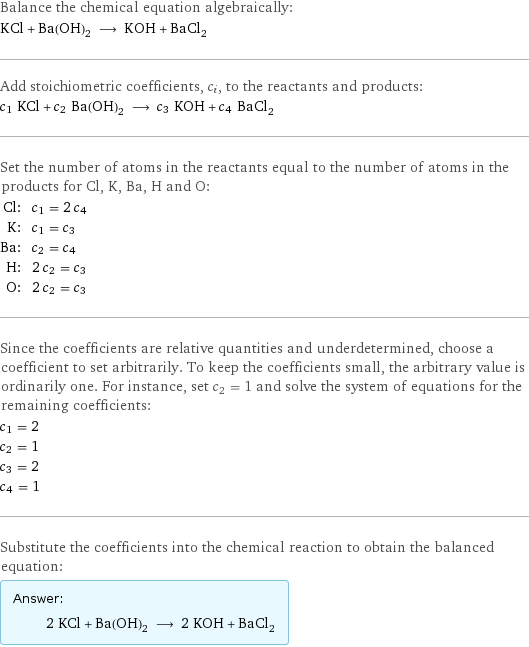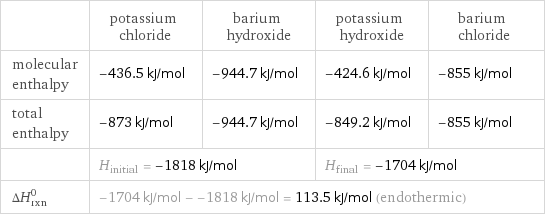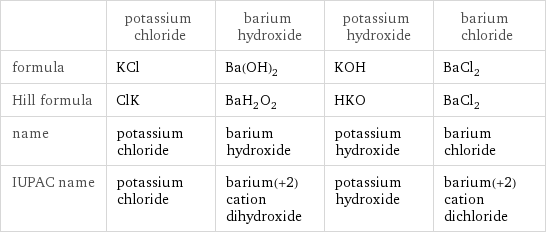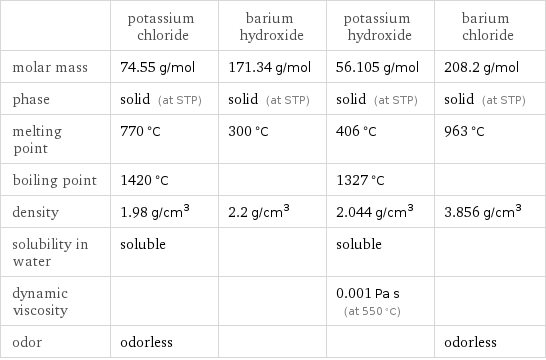Input interpretation

KCl potassium chloride + Ba(OH)_2 barium hydroxide ⟶ KOH potassium hydroxide + BaCl_2 barium chloride
Balanced equation

Balance the chemical equation algebraically: KCl + Ba(OH)_2 ⟶ KOH + BaCl_2 Add stoichiometric coefficients, c_i, to the reactants and products: c_1 KCl + c_2 Ba(OH)_2 ⟶ c_3 KOH + c_4 BaCl_2 Set the number of atoms in the reactants equal to the number of atoms in the products for Cl, K, Ba, H and O: Cl: | c_1 = 2 c_4 K: | c_1 = c_3 Ba: | c_2 = c_4 H: | 2 c_2 = c_3 O: | 2 c_2 = c_3 Since the coefficients are relative quantities and underdetermined, choose a coefficient to set arbitrarily. To keep the coefficients small, the arbitrary value is ordinarily one. For instance, set c_2 = 1 and solve the system of equations for the remaining coefficients: c_1 = 2 c_2 = 1 c_3 = 2 c_4 = 1 Substitute the coefficients into the chemical reaction to obtain the balanced equation: Answer: | | 2 KCl + Ba(OH)_2 ⟶ 2 KOH + BaCl_2
Structures

+ ⟶ +
Names

potassium chloride + barium hydroxide ⟶ potassium hydroxide + barium chloride
Reaction thermodynamics
Enthalpy

| potassium chloride | barium hydroxide | potassium hydroxide | barium chloride molecular enthalpy | -436.5 kJ/mol | -944.7 kJ/mol | -424.6 kJ/mol | -855 kJ/mol total enthalpy | -873 kJ/mol | -944.7 kJ/mol | -849.2 kJ/mol | -855 kJ/mol | H_initial = -1818 kJ/mol | | H_final = -1704 kJ/mol | ΔH_rxn^0 | -1704 kJ/mol - -1818 kJ/mol = 113.5 kJ/mol (endothermic) | | |
Equilibrium constant
![Construct the equilibrium constant, K, expression for: KCl + Ba(OH)_2 ⟶ KOH + BaCl_2 Plan: • Balance the chemical equation. • Determine the stoichiometric numbers. • Assemble the activity expression for each chemical species. • Use the activity expressions to build the equilibrium constant expression. Write the balanced chemical equation: 2 KCl + Ba(OH)_2 ⟶ 2 KOH + BaCl_2 Assign stoichiometric numbers, ν_i, using the stoichiometric coefficients, c_i, from the balanced chemical equation in the following manner: ν_i = -c_i for reactants and ν_i = c_i for products: chemical species | c_i | ν_i KCl | 2 | -2 Ba(OH)_2 | 1 | -1 KOH | 2 | 2 BaCl_2 | 1 | 1 Assemble the activity expressions accounting for the state of matter and ν_i: chemical species | c_i | ν_i | activity expression KCl | 2 | -2 | ([KCl])^(-2) Ba(OH)_2 | 1 | -1 | ([Ba(OH)2])^(-1) KOH | 2 | 2 | ([KOH])^2 BaCl_2 | 1 | 1 | [BaCl2] The equilibrium constant symbol in the concentration basis is: K_c Mulitply the activity expressions to arrive at the K_c expression: Answer: | | K_c = ([KCl])^(-2) ([Ba(OH)2])^(-1) ([KOH])^2 [BaCl2] = (([KOH])^2 [BaCl2])/(([KCl])^2 [Ba(OH)2])](../image_source/06a6c53ad05c3b05ed5b93a94b694f1f.png)
Construct the equilibrium constant, K, expression for: KCl + Ba(OH)_2 ⟶ KOH + BaCl_2 Plan: • Balance the chemical equation. • Determine the stoichiometric numbers. • Assemble the activity expression for each chemical species. • Use the activity expressions to build the equilibrium constant expression. Write the balanced chemical equation: 2 KCl + Ba(OH)_2 ⟶ 2 KOH + BaCl_2 Assign stoichiometric numbers, ν_i, using the stoichiometric coefficients, c_i, from the balanced chemical equation in the following manner: ν_i = -c_i for reactants and ν_i = c_i for products: chemical species | c_i | ν_i KCl | 2 | -2 Ba(OH)_2 | 1 | -1 KOH | 2 | 2 BaCl_2 | 1 | 1 Assemble the activity expressions accounting for the state of matter and ν_i: chemical species | c_i | ν_i | activity expression KCl | 2 | -2 | ([KCl])^(-2) Ba(OH)_2 | 1 | -1 | ([Ba(OH)2])^(-1) KOH | 2 | 2 | ([KOH])^2 BaCl_2 | 1 | 1 | [BaCl2] The equilibrium constant symbol in the concentration basis is: K_c Mulitply the activity expressions to arrive at the K_c expression: Answer: | | K_c = ([KCl])^(-2) ([Ba(OH)2])^(-1) ([KOH])^2 [BaCl2] = (([KOH])^2 [BaCl2])/(([KCl])^2 [Ba(OH)2])
Rate of reaction
![Construct the rate of reaction expression for: KCl + Ba(OH)_2 ⟶ KOH + BaCl_2 Plan: • Balance the chemical equation. • Determine the stoichiometric numbers. • Assemble the rate term for each chemical species. • Write the rate of reaction expression. Write the balanced chemical equation: 2 KCl + Ba(OH)_2 ⟶ 2 KOH + BaCl_2 Assign stoichiometric numbers, ν_i, using the stoichiometric coefficients, c_i, from the balanced chemical equation in the following manner: ν_i = -c_i for reactants and ν_i = c_i for products: chemical species | c_i | ν_i KCl | 2 | -2 Ba(OH)_2 | 1 | -1 KOH | 2 | 2 BaCl_2 | 1 | 1 The rate term for each chemical species, B_i, is 1/ν_i(Δ[B_i])/(Δt) where [B_i] is the amount concentration and t is time: chemical species | c_i | ν_i | rate term KCl | 2 | -2 | -1/2 (Δ[KCl])/(Δt) Ba(OH)_2 | 1 | -1 | -(Δ[Ba(OH)2])/(Δt) KOH | 2 | 2 | 1/2 (Δ[KOH])/(Δt) BaCl_2 | 1 | 1 | (Δ[BaCl2])/(Δt) (for infinitesimal rate of change, replace Δ with d) Set the rate terms equal to each other to arrive at the rate expression: Answer: | | rate = -1/2 (Δ[KCl])/(Δt) = -(Δ[Ba(OH)2])/(Δt) = 1/2 (Δ[KOH])/(Δt) = (Δ[BaCl2])/(Δt) (assuming constant volume and no accumulation of intermediates or side products)](../image_source/881f331e3bdd38360baea21162810beb.png)
Construct the rate of reaction expression for: KCl + Ba(OH)_2 ⟶ KOH + BaCl_2 Plan: • Balance the chemical equation. • Determine the stoichiometric numbers. • Assemble the rate term for each chemical species. • Write the rate of reaction expression. Write the balanced chemical equation: 2 KCl + Ba(OH)_2 ⟶ 2 KOH + BaCl_2 Assign stoichiometric numbers, ν_i, using the stoichiometric coefficients, c_i, from the balanced chemical equation in the following manner: ν_i = -c_i for reactants and ν_i = c_i for products: chemical species | c_i | ν_i KCl | 2 | -2 Ba(OH)_2 | 1 | -1 KOH | 2 | 2 BaCl_2 | 1 | 1 The rate term for each chemical species, B_i, is 1/ν_i(Δ[B_i])/(Δt) where [B_i] is the amount concentration and t is time: chemical species | c_i | ν_i | rate term KCl | 2 | -2 | -1/2 (Δ[KCl])/(Δt) Ba(OH)_2 | 1 | -1 | -(Δ[Ba(OH)2])/(Δt) KOH | 2 | 2 | 1/2 (Δ[KOH])/(Δt) BaCl_2 | 1 | 1 | (Δ[BaCl2])/(Δt) (for infinitesimal rate of change, replace Δ with d) Set the rate terms equal to each other to arrive at the rate expression: Answer: | | rate = -1/2 (Δ[KCl])/(Δt) = -(Δ[Ba(OH)2])/(Δt) = 1/2 (Δ[KOH])/(Δt) = (Δ[BaCl2])/(Δt) (assuming constant volume and no accumulation of intermediates or side products)
Chemical names and formulas

| potassium chloride | barium hydroxide | potassium hydroxide | barium chloride formula | KCl | Ba(OH)_2 | KOH | BaCl_2 Hill formula | ClK | BaH_2O_2 | HKO | BaCl_2 name | potassium chloride | barium hydroxide | potassium hydroxide | barium chloride IUPAC name | potassium chloride | barium(+2) cation dihydroxide | potassium hydroxide | barium(+2) cation dichloride
Substance properties

| potassium chloride | barium hydroxide | potassium hydroxide | barium chloride molar mass | 74.55 g/mol | 171.34 g/mol | 56.105 g/mol | 208.2 g/mol phase | solid (at STP) | solid (at STP) | solid (at STP) | solid (at STP) melting point | 770 °C | 300 °C | 406 °C | 963 °C boiling point | 1420 °C | | 1327 °C | density | 1.98 g/cm^3 | 2.2 g/cm^3 | 2.044 g/cm^3 | 3.856 g/cm^3 solubility in water | soluble | | soluble | dynamic viscosity | | | 0.001 Pa s (at 550 °C) | odor | odorless | | | odorless
Units
